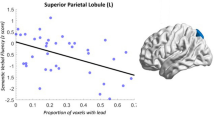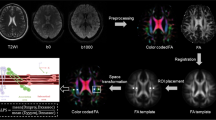Abstract
Schizophrenia is considered to be a disorder of brain connectivity, which might result from a disproportionally impaired rich-club organization. The rich-club is composed of highly interconnected hub regions that play crucial roles in integrating information between different brain regions. Few studies have yet investigated whether the structural rich-club organization is impaired in patients and their first-degree relatives. In this study, we established a weighted network model of white matter connections using diffusion tensor imaging of 19 patients and 39 unaffected parents, 22 young healthy controls for the patients, and 25 old healthy controls for the parents. Feeder edges between rich-club nodes and non-rich-club nodes were significantly decreased in both schizophrenic patients and their unaffected parents compared with controls. Furthermore, the feeder edges showed significant positive correlations with the scores in Category Fluency Test—animal naming in the unaffected parents. Specific feeder edges exhibited discriminative power with accuracy of 84.4% in distinguishing unaffected parents from old healthy controls. Our findings suggest that impaired rich-club organization, especially impaired feeder edges, may be related to familial vulnerability to schizophrenia, possibly reflecting a genetic predisposition for schizophrenia.



Similar content being viewed by others
References
Mueser KT, McGurk SR. Schizophrenia. Lancet 2004, 363: 2063–2072.
Fatouros-Bergman H, Cervenka S, Flyckt L, Edman G, Farde L. Meta-analysis of cognitive performance in drug-naive patients with schizophrenia. Schizophr Res 2014, 158: 156–162.
Bienvenu OJ, Davydow DS, Kendler KS. Psychiatric ‘diseases’ versus behavioral disorders and degree of genetic influence. Psychol Med 2011, 41: 33–40.
Sullivan PF, Kendler KS, Neale MC. Schizophrenia as a complex trait: evidence from a meta-analysis of twin studies. Arch Gen Psychiatry 2003, 60: 1187–1192.
van Haren NE, Rijsdijk F, Schnack HG, Picchioni MM, Toulopoulou T, Weisbrod M, et al. The genetic and environmental determinants of the association between brain abnormalities and schizophrenia: the schizophrenia twins and relatives consortium. Biol Psychiatry 2012, 71: 915–921.
Geisler D, Walton E, Naylor M, Roessner V, Lim KO, Charles Schulz S, et al. Brain structure and function correlates of cognitive subtypes in schizophrenia. Psychiatry Res 2015, 234: 74–83.
Towlson EK, Vertes PE, Ahnert SE, Schafer WR, Bullmore ET. The rich-club of the C. elegans neuronal connectome. J Neurosci 2013, 33: 6380–6387.
van den Heuvel MP, Sporns O. Network hubs in the human brain. Trends Cogn Sci 2013, 17: 683–696.
van den Heuvel MP, Sporns O, Collin G, Scheewe T, Mandl RC, Cahn W, et al. Abnormal rich-club organization and functional brain dynamics in schizophrenia. JAMA Psychiatry 2013, 70: 783–792.
Zamora-Lopez G, Zhou C, Kurths J. Graph analysis of cortical networks reveals complex anatomical communication substrate. Chaos 2009, 19: 015117.
Stephan KE, Friston KJ, Frith CD. Dysconnection in schizophrenia: from abnormal synaptic plasticity to failures of self-monitoring. Schizophr Bull 2009, 35: 509–527.
Fornito A, Zalesky A, Pantelis C, Bullmore ET. Schizophrenia, neuroimaging and connectomics. Neuroimage 2012, 62: 2296–2314.
Whitford TJ, Kubicki M, Shenton ME. Diffusion tensor imaging, structural connectivity, and schizophrenia. Schizophr Res Treatment 2011, 2011: 709523.
Zalesky A, Fornito A, Seal ML, Cocchi L, Westin CF, Bullmore ET, et al. Disrupted axonal fiber connectivity in schizophrenia. Biol Psychiatry 2011, 69: 80-89.
van den Heuvel MP, Sporns O. Rich-club organization of the human connectome. J Neurosci 2011, 31: 15775–15786.
Ottet M-C, Schaer M, Debbané M, Cammoun L, Thiran JP, Eliez S. Graph theory reveals dysconnected hubs in 22q11DS and altered nodal efficiency in patients with hallucinations. Front Hum Neurosci 2013, 7: 402.
Zhang Y, Lin L, Lin CP, Zhou Y, Chou KH, Lo CY, et al. Abnormal topological organization of structural brain networks in schizophrenia. Schizophr Res 2012, 141: 109–118.
Wang Q, Su TP, Zhou Y, Chou KH, Chen IY, Jiang T, et al. Anatomical insights into disrupted small-world networks in schizophrenia. Neuroimage 2012, 59: 1085–1093.
Ellison-Wright I, Bullmore E. Meta-analysis of diffusion tensor imaging studies in schizophrenia. Schizophr Res 2009, 108: 3–10.
Kubicki M, Westin CF, McCarley RW, Shenton ME. The application of DTI to investigate white matter abnormalities in schizophrenia. Ann N Y Acad Sci 2005, 1064: 134–148.
Kubicki M, Shenton ME, Maciejewski PK, Pelavin PE, Hawley KJ, Ballinger T, et al. Decreased axial diffusivity within language connections: a possible biomarker of schizophrenia risk. Schizophr Res 2013, 148: 67–73.
Skudlarski P, Schretlen DJ, Thaker GK, Stevens MC, Keshavan MS, Sweeney JA, et al. Diffusion tensor imaging white matter endophenotypes in patients with schizophrenia or psychotic bipolar disorder and their relatives. Am J Psychiatry 2013, 170: 886–898.
Repovs G, Csernansky JG, Barch DM. Brain network connectivity in individuals with schizophrenia and their siblings. Biol Psychiatry 2011, 69: 967–973.
Li M, Li T. Altered topological properties in the heritable schizophrenic brain. Neurosci Bull 2015, 31: 515–516.
Collin G, Kahn RS, de Reus MA, Cahn W, van den Heuvel MP. Impaired rich-club connectivity in unaffected siblings of schizophrenic patients. Schizophr Bull 2014, 40: 438–448.
Yan H, Tian L, Wang Q, Zhao Q, Yue W, Yan J, et al. Compromised small-world efficiency of structural brain networks in schizophrenic patients and their unaffected parents. Neurosci Bull 2015, 31: 275–287.
Zalesky A, Fornito A, Bullmore ET. Network-based statistic: identifying differences in brain networks. Neuroimage 2010, 53: 1197–1207.
Shekhar S, Benedetto S. The ICD-10 classification of mental and behavioural disorders. World Health Organization, 1993.
Woods SW. Chlorpromazine equivalent doses for the newer atypical antipsychotics. J Clin Psychiatry 2003, 64: 663–667.
Kay SR, Fiszbein A, Opler LA. The positive and negative syndrome scale (PANSS) for schizophrenia. Schizophr Bull 1987, 13: 261–276.
Strauss E, Sherman EMS, Spreen O. A compendium of neuropsychological tests: Administration, norms, and commentary (3rd. ed). Cogn Behav Neurol 1998, 12: 70–71.
Shallice T. Specific impairments of planning. Philos Trans R Soc Lond B Biol Sci 1982, 298: 199–209.
Wechsler D. Manual for the Wechsler Memory Scale-Revised. San Antonio, TX: The Psychological Corporation, 1987.
Cui Z, Zhong S, Xu P, He Y, Gong G. PANDA: a pipeline toolbox for analyzing brain diffusion images. Front Hum Neurosci 2013, 7: 42.
Wang J, Wang X, Xia M, Liao X, Evans A, He Y. GRETNA: a graph theoretical network analysis toolbox for imaging connectomics. Front Hum Neurosci 2015, 9: 386.
Xia M, Wang J, He Y. BrainNet Viewer: a network visualization tool for human brain connectomics. PLoS One 2013, 8: e68910.
Fawcett T. An introduction to ROC analysis. Pattern Recognit Lett 2006, 27: 861–874.
Yu Q, Sui J, Liu J, Plis SM, Kiehl KA, Pearlson G, et al. Disrupted correlation between low frequency power and connectivity strength of resting state brain networks in schizophrenia. Schizophr Res 2013, 143: 165–171.
van den Heuvel MP, Fornito A. Brain networks in schizophrenia. Neuropsychol Rev 2014, 24: 32–48.
Gong G, He Y, Concha L, Lebel C, Gross DW, Evans AC, et al. Mapping anatomical connectivity patterns of human cerebral cortex using in vivo diffusion tensor imaging tractography. Cereb Cortex 2009, 19: 524–536.
Hagmann P, Cammoun L, Gigandet X, Meuli R, Honey CJ, Wedeen VJ, et al. Mapping the structural core of human cerebral cortex. PLoS Biol 2008, 6: e159.
Bassett DS, Bullmore E, Verchinski BA, Mattay VS, Weinberger DR, Meyer-Lindenberg A. Hierarchical organization of human cortical networks in health and schizophrenia. J Neurosci 2008, 28: 9239–9248.
Shi F, Yap PT, Gao W, Lin W, Gilmore JH, Shen D. Altered structural connectivity in neonates at genetic risk for schizophrenia: a combined study using morphological and white matter networks. Neuroimage 2012, 62: 1622–1633.
Rubinov M, Bullmore E. Schizophrenia and abnormal brain network hubs. Dialogues Clin Neurosci 2013, 15: 339–349.
Hao Y, Yan Q, Liu H, Xu L, Xue Z, Song X, et al. Schizophrenic patients and their healthy siblings share disruption of white matter integrity in the left prefrontal cortex and the hippocampus but not the anterior cingulate cortex. Schizophr Res 2009, 114: 128–135.
Camchong J, Lim KO, Sponheim SR, Macdonald AW. Frontal white matter integrity as an endophenotype for schizophrenia: diffusion tensor imaging in monozygotic twins and patients’ nonpsychotic relatives. Front Hum Neurosci 2009, 3: 35.
Knochel C, O’Dwyer L, Alves G, Reinke B, Magerkurth J, Rotarska-Jagiela A, et al. Association between white matter fiber integrity and subclinical psychotic symptoms in schizophrenic patients and unaffected relatives. Schizophr Res 2012, 140: 129–135.
Knochel C, Oertel-Knochel V, Schonmeyer R, Rotarska-Jagiela A, van de Ven V, Prvulovic D, et al. Interhemispheric hypoconnectivity in schizophrenia: fiber integrity and volume differences of the corpus callosum in patients and unaffected relatives. Neuroimage 2012, 59: 926–934.
Schmidt A, Crossley NA, Harrisberger F, Smieskova R, Lenz C, Riecher-Rossler A, et al. Structural network disorganization in subjects at clinical high risk for psychosis. Schizophr Bull 2017, 43: 583–591.
Cardno AG, Gottesman, II. Twin studies of schizophrenia: from bow-and-arrow concordances to star wars Mx and functional genomics. Am J Med Genet 2000, 97: 12–17.
Kendler KS. The genetics of schizophrenia: chromosomal deletions, attentional disturbances, and spectrum boundaries. Am J Psychiatry 2003, 160: 1549–1553.
Diwadkar VA, Wadehra S, Pruitt P, Keshavan MS, Rajan U, Zajac-Benitez C, et al. Disordered corticolimbic interactions during affective processing in children and adolescents at risk for schizophrenia revealed by functional magnetic resonance imaging and dynamic causal modeling. Arch Gen Psychiatry 2012, 69: 231–242.
Glahn DC, Winkler AM, Kochunov P, Almasy L, Duggirala R, Carless MA, et al. Genetic control over the resting brain. Proc Natl Acad Sci U S A 2010, 107: 1223–1228.
Fornito A, Zalesky A, Bassett DS, Meunier D, Ellison-Wright I, Yucel M, et al. Genetic influences on cost-efficient organization of human cortical functional networks. J Neurosci 2011, 31: 3261–3270.
van den Heuvel MP, van Soelen IL, Stam CJ, Kahn RS, Boomsma DI, Hulshoff Pol HE. Genetic control of functional brain network efficiency in children. Eur Neuropsychopharmacol 2013, 23: 19–23.
Hoptman MJ, Nierenberg J, Bertisch HC, Catalano D, Ardekani BA, Branch CA, et al. A DTI study of white matter microstructure in individuals at high genetic risk for schizophrenia. Schizophr Res 2008, 106: 115–124.
van den Heuvel MP, Sporns O. An anatomical substrate for integration among functional networks in human cortex. J Neurosci 2013, 33: 14489–14500.
Lencz T, Knowles E, Davies G, Guha S, Liewald DC, Starr JM, et al. Molecular genetic evidence for overlap between general cognitive ability and risk for schizophrenia: a report from the Cognitive Genomics consorTium (COGENT). Mol Psychiatry 2014, 19: 168–174.
Yeo RA, Ryman SG, van den Heuvel MP, de Reus MA, Jung RE, Pommy J, et al. Graph metrics of structural brain networks in individuals with schizophrenia and healthy controls: group differences, relationships with intelligence, and genetics. J Int Neuropsychol Soc 2016, 22: 240–249.
Li K, Liu L, Yin Q, Dun W, Xu X, Liu J, et al. Abnormal rich-club organization and impaired correlation between structural and functional connectivity in migraine sufferers. Brain Imaging Behav 2017, 11: 526–540.
Acknowledgements
This work was supported by grants from the National Basic Research Program of China (2011CB707805), the National Natural Science Foundation of China (81370032, 91232305, 81361120395, and 91432304), and the International Science and Technology Cooperation Program of China (2010DFB30820).
Author information
Authors and Affiliations
Corresponding authors
Rights and permissions
About this article
Cite this article
Zhao, X., Tian, L., Yan, J. et al. Abnormal Rich-Club Organization Associated with Compromised Cognitive Function in Patients with Schizophrenia and Their Unaffected Parents. Neurosci. Bull. 33, 445–454 (2017). https://doi.org/10.1007/s12264-017-0151-0
Received:
Accepted:
Published:
Issue Date:
DOI: https://doi.org/10.1007/s12264-017-0151-0




